homelink NISSAN LEAF 2020 Owner´s Manual
[x] Cancel search | Manufacturer: NISSAN, Model Year: 2020, Model line: LEAF, Model: NISSAN LEAF 2020Pages: 596, PDF Size: 4.33 MB
Page 14 of 596
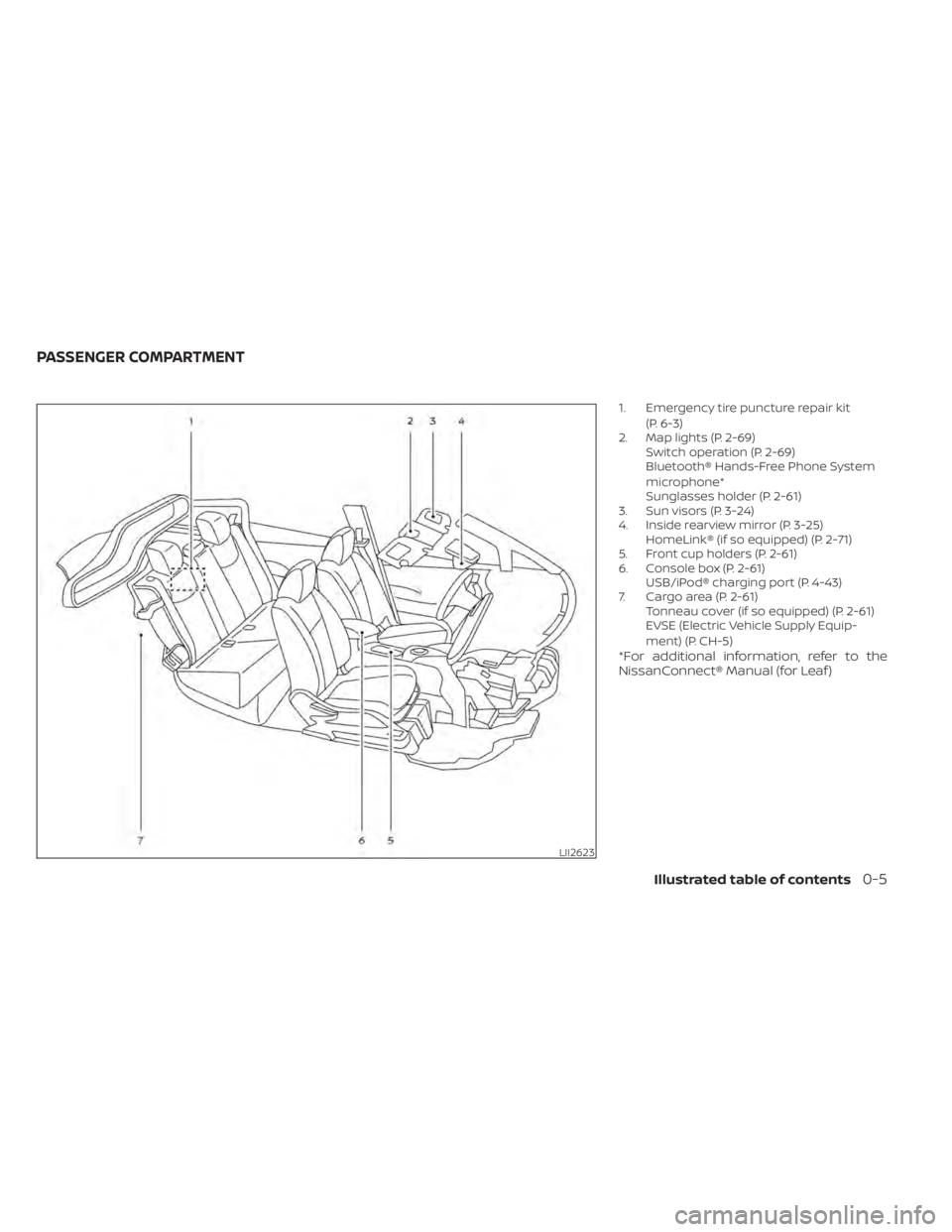
1. Emergency tire puncture repair kit(P. 6-3)
2. Map lights (P. 2-69) Switch operation (P. 2-69)
Bluetooth® Hands-Free Phone System
microphone*
Sunglasses holder (P. 2-61)
3. Sun visors (P. 3-24)
4. Inside rearview mirror (P. 3-25) HomeLink® (if so equipped) (P. 2-71)
5. Front cup holders (P. 2-61)
6. Console box (P. 2-61) USB/iPod® charging port (P. 4-43)
7. Cargo area (P. 2-61) Tonneau cover (if so equipped) (P. 2-61)
EVSE (Electric Vehicle Supply Equip-
ment) (P. CH-5)
*For additional information, refer to the
NissanConnect® Manual (for Leaf )
LII2623
PASSENGER COMPARTMENT
Illustrated table of contents0-5
Page 174 of 596

Dynamic driver assistance switch
(for vehicles without ProPILOT Assist)
(if so equipped)................................. 2-59
Steering Assist switch (for models with
ProPILOT Assist) (if so equipped) ................2-59
Rear Door Alert ................................. 2-60
Power outlet ................................... 2-61
Storage ........................................ 2-61
Seatback Pocket ............................ 2-61
Storagetray................................. 2-62
Glovebox ................................... 2-62
Console box ................................. 2-63
Overhead sunglasses storage ...............2-63
Cup holders ................................. 2-64
Tonneau cover (if so equipped) ..............2-65
Stowing golf bags ........................... 2-66
Windows ....................................... 2-66
Power windows ............................. 2-66Interior lights
................................... 2-69
Console light (if so equipped) ................2-69
Map lights ................................... 2-69
Room light .................................. 2-70
Cargo light .................................. 2-70
HomeLink® Universal Transceiver
(if so equipped) ................................. 2-71
Programming HomeLink® ...................2-71
Programming HomeLink® for Canadian
customers and gate openers ...............2-73
Operating the HomeLink® Universal
Transceiver ..................................2-74
Programming trouble-diagnosis ............2-74
Clearing the programmed information ......2-74
Reprogramming a single HomeLink®
button ...................................... 2-75
If your vehicle is stolen ......................2-75
Page 244 of 596
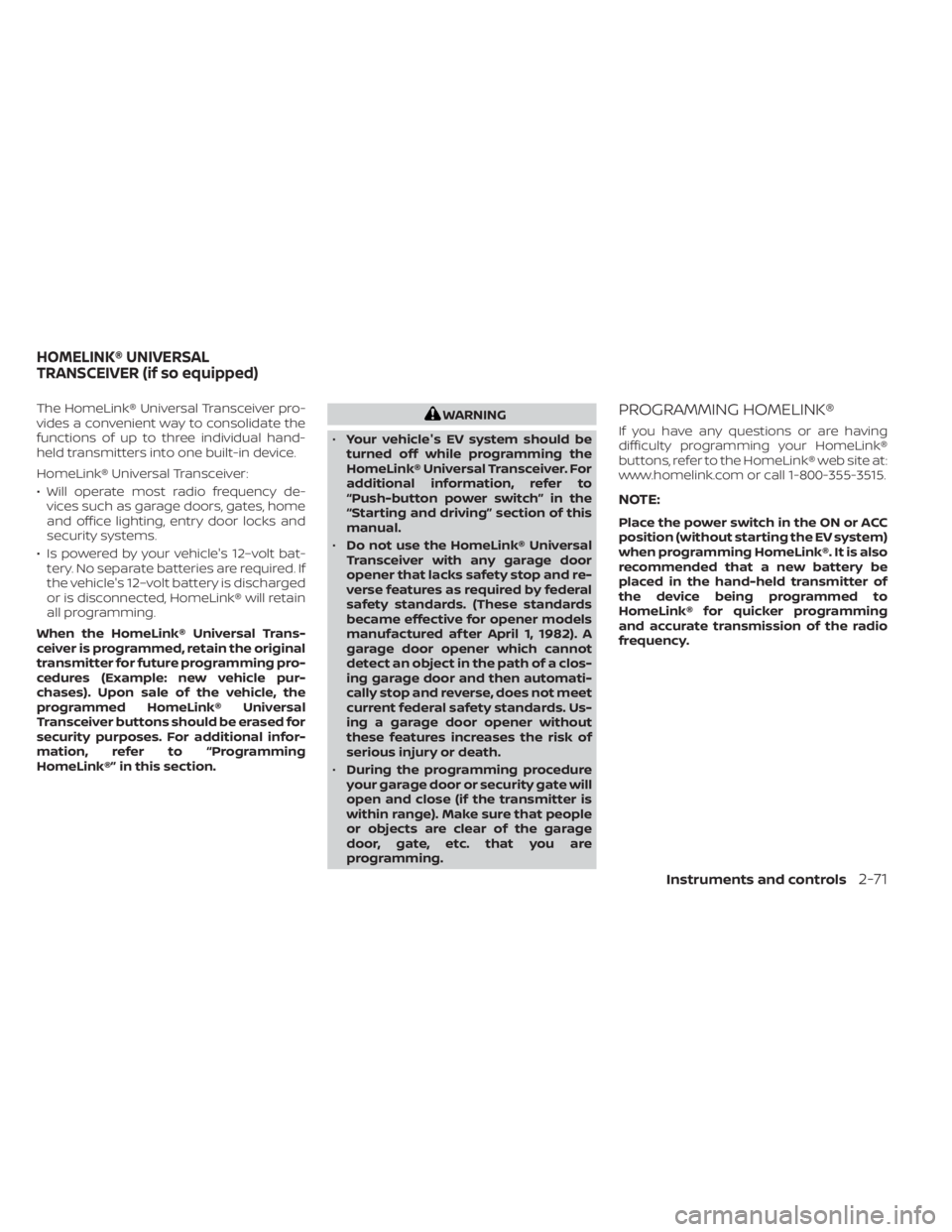
The HomeLink® Universal Transceiver pro-
vides a convenient way to consolidate the
functions of up to three individual hand-
held transmitters into one built-in device.
HomeLink® Universal Transceiver:
• Will operate most radio frequency de-vices such as garage doors, gates, home
and office lighting, entry door locks and
security systems.
• Is powered by your vehicle's 12–volt bat- tery. No separate batteries are required. If
the vehicle's 12–volt battery is discharged
or is disconnected, HomeLink® will retain
all programming.
When the HomeLink® Universal Trans-
ceiver is programmed, retain the original
transmitter for future programming pro-
cedures (Example: new vehicle pur-
chases). Upon sale of the vehicle, the
programmed HomeLink® Universal
Transceiver buttons should be erased for
security purposes. For additional infor-
mation, refer to “Programming
HomeLink®” in this section.WARNING
• Your vehicle's EV system should be
turned off while programming the
HomeLink® Universal Transceiver. For
additional information, refer to
“Push-button power switch” in the
“Starting and driving” section of this
manual.
• Do not use the HomeLink® Universal
Transceiver with any garage door
opener that lacks safety stop and re-
verse features as required by federal
safety standards. (These standards
became effective for opener models
manufactured af ter April 1, 1982). A
garage door opener which cannot
detect an object in the path of a clos-
ing garage door and then automati-
cally stop and reverse, does not meet
current federal safety standards. Us-
ing a garage door opener without
these features increases the risk of
serious injury or death.
• During the programming procedure
your garage door or security gate will
open and close (if the transmitter is
within range). Make sure that people
or objects are clear of the garage
door, gate, etc. that you are
programming.PROGRAMMING HOMELINK®
If you have any questions or are having
difficulty programming your HomeLink®
buttons, refer to the HomeLink® web site at:
www.homelink.com or call 1-800-355-3515.
NOTE:
Place the power switch in the ON or ACC
position (without starting the EV system)
when programming HomeLink®. It is also
recommended that a new battery be
placed in the hand-held transmitter of
the device being programmed to
HomeLink® for quicker programming
and accurate transmission of the radio
frequency.
HOMELINK® UNIVERSAL
TRANSCEIVER (if so equipped)
Instruments and controls2-71
Page 245 of 596
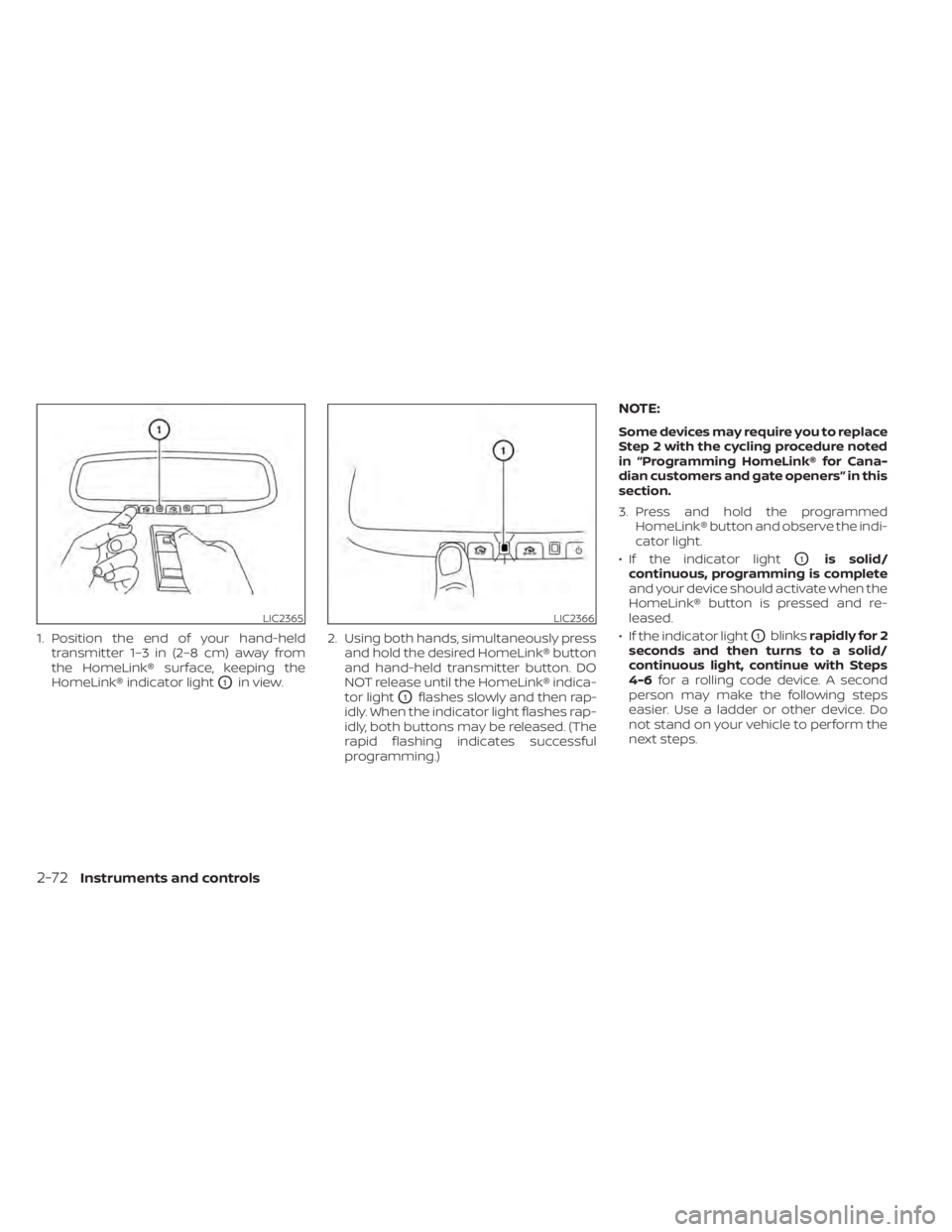
1. Position the end of your hand-heldtransmitter 1–3 in (2–8 cm) away from
the HomeLink® surface, keeping the
HomeLink® indicator light
O1in view. 2. Using both hands, simultaneously press
and hold the desired HomeLink® button
and hand-held transmitter button. DO
NOT release until the HomeLink® indica-
tor light
O1flashes slowly and then rap-
idly. When the indicator light flashes rap-
idly, both buttons may be released. (The
rapid flashing indicates successful
programming.)
NOTE:
Some devices may require you to replace
Step 2 with the cycling procedure noted
in “Programming HomeLink® for Cana-
dian customers and gate openers” in this
section.
3. Press and hold the programmed HomeLink® button and observe the indi-
cator light.
• If the indicator light
O1is solid/
continuous, programming is complete
and your device should activate when the
HomeLink® button is pressed and re-
leased.
• If the indicator light
O1blinks rapidly for 2
seconds and then turns to a solid/
continuous light, continue with Steps
4-6 for a rolling code device. A second
person may make the following steps
easier. Use a ladder or other device. Do
not stand on your vehicle to perform the
next steps.
LIC2365LIC2366
2-72Instruments and controls
Page 246 of 596
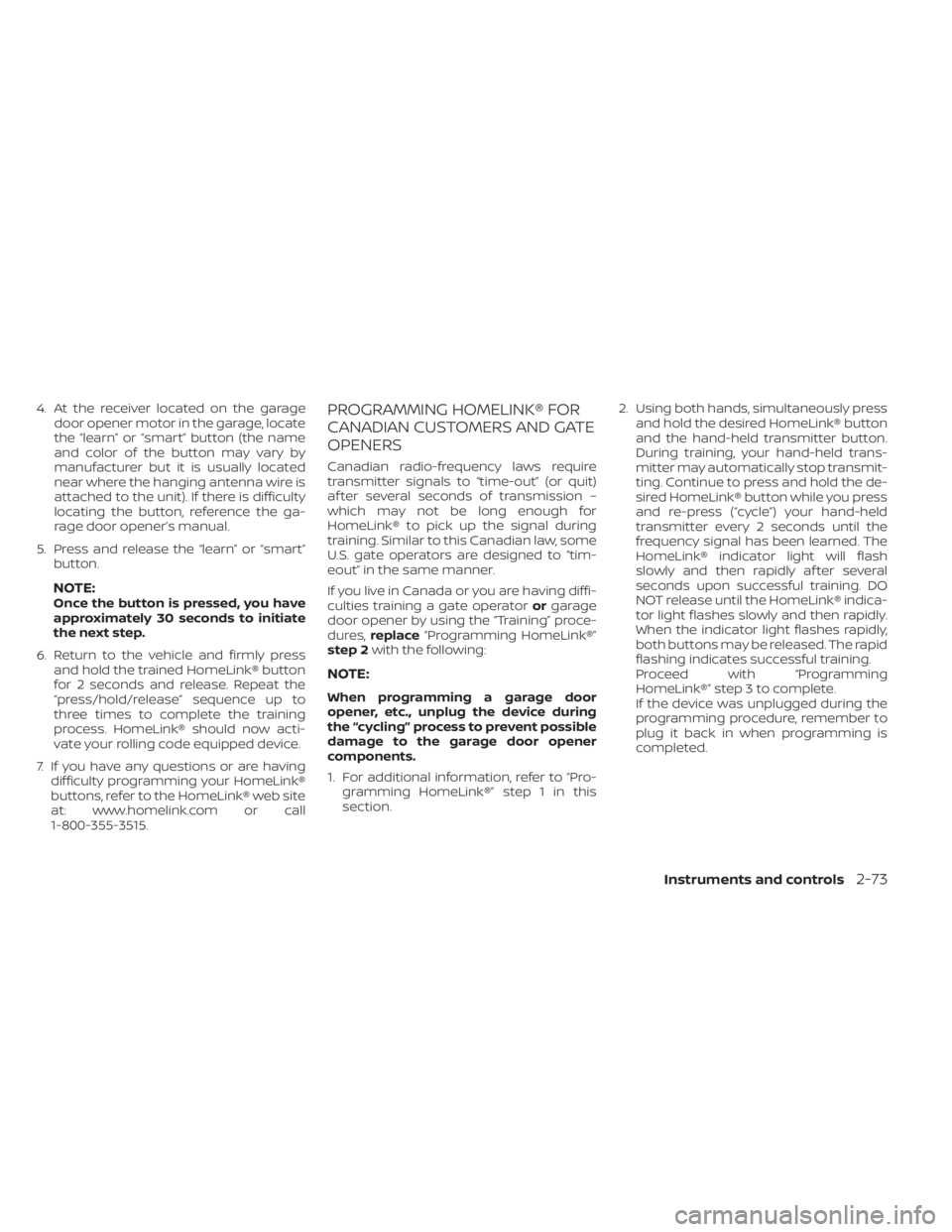
4. At the receiver located on the garagedoor opener motor in the garage, locate
the “learn” or “smart” button (the name
and color of the button may vary by
manufacturer but it is usually located
near where the hanging antenna wire is
attached to the unit). If there is difficulty
locating the button, reference the ga-
rage door opener’s manual.
5. Press and release the “learn” or “smart” button.
NOTE:Once the button is pressed, you have
approximately 30 seconds to initiate
the next step.
6. Return to the vehicle and firmly press and hold the trained HomeLink® button
for 2 seconds and release. Repeat the
“press/hold/release” sequence up to
three times to complete the training
process. HomeLink® should now acti-
vate your rolling code equipped device.
7. If you have any questions or are having difficulty programming your HomeLink®
buttons, refer to the HomeLink® web site
at: www.homelink.com or call
1-800-355-3515.
PROGRAMMING HOMELINK® FOR
CANADIAN CUSTOMERS AND GATE
OPENERS
Canadian radio-frequency laws require
transmitter signals to “time-out” (or quit)
af ter several seconds of transmission –
which may not be long enough for
HomeLink® to pick up the signal during
training. Similar to this Canadian law, some
U.S. gate operators are designed to “tim-
eout” in the same manner.
If you live in Canada or you are having diffi-
culties training a gate operator orgarage
door opener by using the “Training” proce-
dures, replace “Programming HomeLink®”
step 2 with the following:
NOTE:
When programming a garage door
opener, etc., unplug the device during
the “cycling” process to prevent possible
damage to the garage door opener
components.
1. For additional information, refer to “Pro-
gramming HomeLink®” step 1 in this
section. 2. Using both hands, simultaneously press
and hold the desired HomeLink® button
and the hand-held transmitter button.
During training, your hand-held trans-
mitter may automatically stop transmit-
ting. Continue to press and hold the de-
sired HomeLink® button while you press
and re-press (“cycle”) your hand-held
transmitter every 2 seconds until the
frequency signal has been learned. The
HomeLink® indicator light will flash
slowly and then rapidly af ter several
seconds upon successful training. DO
NOT release until the HomeLink® indica-
tor light flashes slowly and then rapidly.
When the indicator light flashes rapidly,
both buttons may be released. The rapid
flashing indicates successful training.
Proceed with “Programming
HomeLink®” step 3 to complete.
If the device was unplugged during the
programming procedure, remember to
plug it back in when programming is
completed.
Instruments and controls2-73
Page 247 of 596
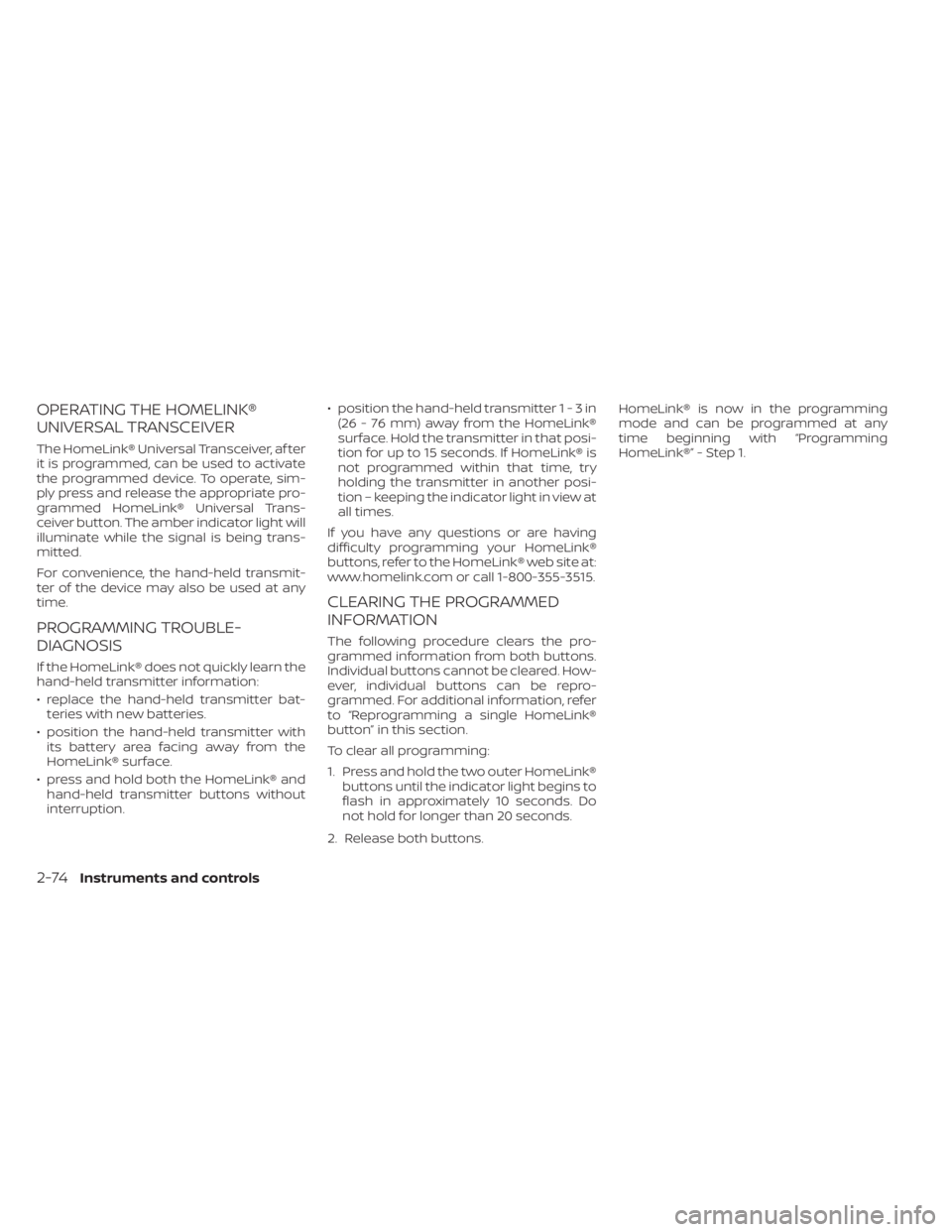
OPERATING THE HOMELINK®
UNIVERSAL TRANSCEIVER
The HomeLink® Universal Transceiver, af ter
it is programmed, can be used to activate
the programmed device. To operate, sim-
ply press and release the appropriate pro-
grammed HomeLink® Universal Trans-
ceiver button. The amber indicator light will
illuminate while the signal is being trans-
mitted.
For convenience, the hand-held transmit-
ter of the device may also be used at any
time.
PROGRAMMING TROUBLE-
DIAGNOSIS
If the HomeLink® does not quickly learn the
hand-held transmitter information:
• replace the hand-held transmitter bat-teries with new batteries.
• position the hand-held transmitter with its battery area facing away from the
HomeLink® surface.
• press and hold both the HomeLink® and hand-held transmitter buttons without
interruption. • position the hand-held transmitter1-3in
(26 - 76 mm) away from the HomeLink®
surface. Hold the transmitter in that posi-
tion for up to 15 seconds. If HomeLink® is
not programmed within that time, try
holding the transmitter in another posi-
tion – keeping the indicator light in view at
all times.
If you have any questions or are having
difficulty programming your HomeLink®
buttons, refer to the HomeLink® web site at:
www.homelink.com or call 1-800-355-3515.
CLEARING THE PROGRAMMED
INFORMATION
The following procedure clears the pro-
grammed information from both buttons.
Individual buttons cannot be cleared. How-
ever, individual buttons can be repro-
grammed. For additional information, refer
to “Reprogramming a single HomeLink®
button” in this section.
To clear all programming:
1. Press and hold the two outer HomeLink® buttons until the indicator light begins to
flash in approximately 10 seconds. Do
not hold for longer than 20 seconds.
2. Release both buttons. HomeLink® is now in the programming
mode and can be programmed at any
time beginning with “Programming
HomeLink®” - Step 1.
2-74Instruments and controls
Page 248 of 596
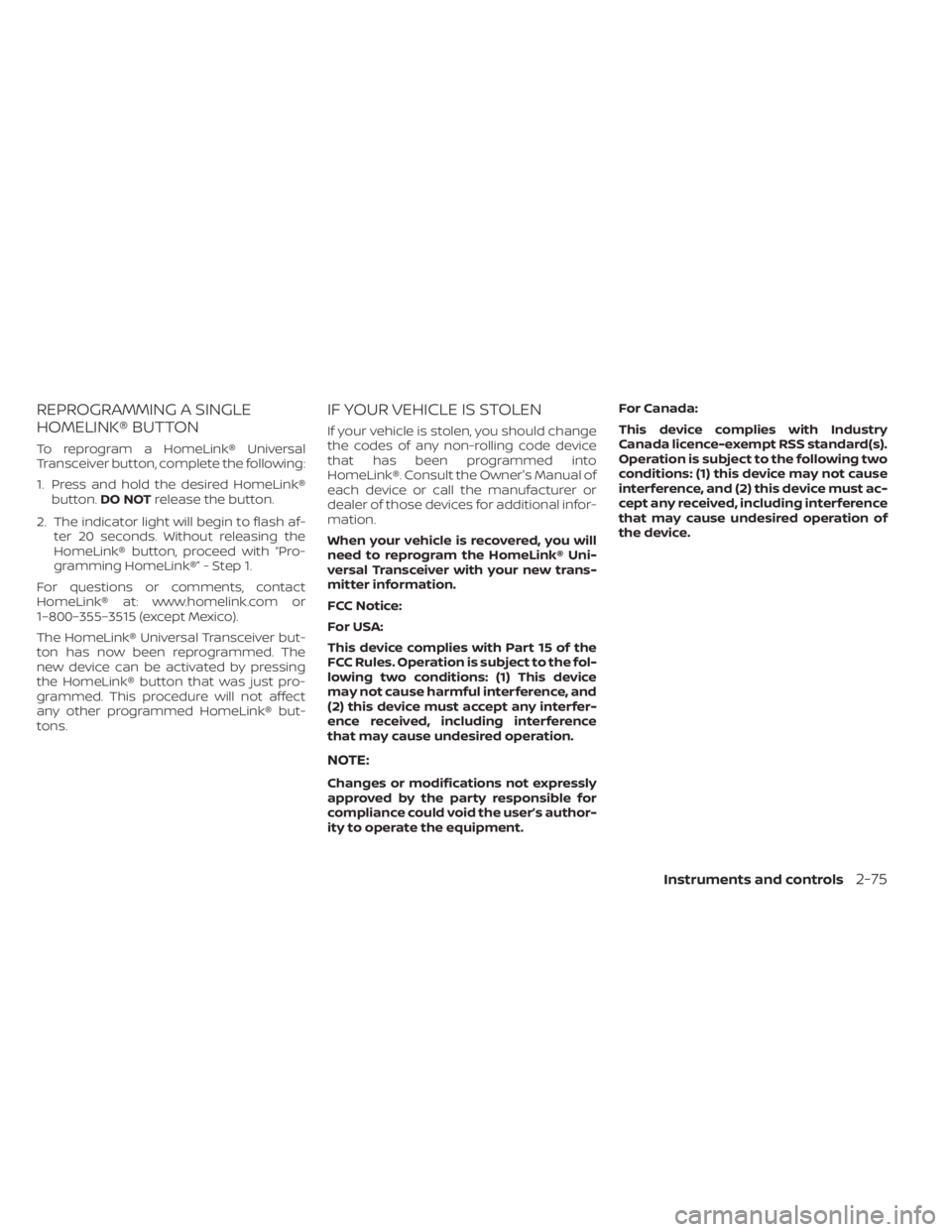
REPROGRAMMING A SINGLE
HOMELINK® BUTTON
To reprogram a HomeLink® Universal
Transceiver button, complete the following:
1. Press and hold the desired HomeLink®button. DO NOT release the button.
2. The indicator light will begin to flash af- ter 20 seconds. Without releasing the
HomeLink® button, proceed with “Pro-
gramming HomeLink®” - Step 1.
For questions or comments, contact
HomeLink® at: www.homelink.com or
1–800–355–3515 (except Mexico).
The HomeLink® Universal Transceiver but-
ton has now been reprogrammed. The
new device can be activated by pressing
the HomeLink® button that was just pro-
grammed. This procedure will not affect
any other programmed HomeLink® but-
tons.
IF YOUR VEHICLE IS STOLEN
If your vehicle is stolen, you should change
the codes of any non-rolling code device
that has been programmed into
HomeLink®. Consult the Owner's Manual of
each device or call the manufacturer or
dealer of those devices for additional infor-
mation.
When your vehicle is recovered, you will
need to reprogram the HomeLink® Uni-
versal Transceiver with your new trans-
mitter information.
FCC Notice:
For USA:
This device complies with Part 15 of the
FCC Rules. Operation is subject to the fol-
lowing two conditions: (1) This device
may not cause harmful interference, and
(2) this device must accept any interfer-
ence received, including interference
that may cause undesired operation.
NOTE:
Changes or modifications not expressly
approved by the party responsible for
compliance could void the user’s author-
ity to operate the equipment. For Canada:
This device complies with Industry
Canada licence-exempt RSS standard(s).
Operation is subject to the following two
conditions: (1) this device may not cause
interference, and (2) this device must ac-
cept any received, including interference
that may cause undesired operation of
the device.
Instruments and controls2-75
Page 275 of 596
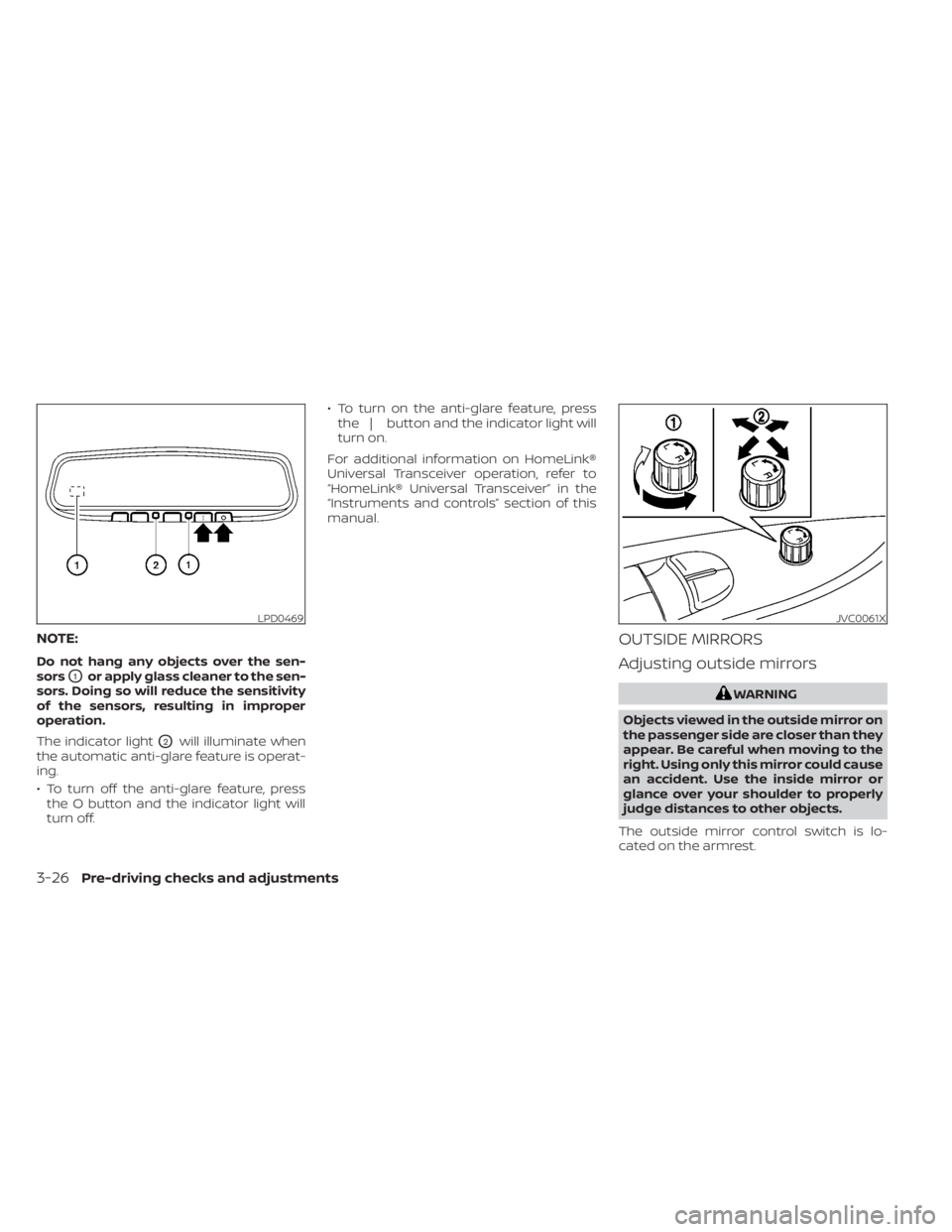
NOTE:
Do not hang any objects over the sen-
sors
O1or apply glass cleaner to the sen-
sors. Doing so will reduce the sensitivity
of the sensors, resulting in improper
operation.
The indicator light
O2will illuminate when
the automatic anti-glare feature is operat-
ing.
• To turn off the anti-glare feature, press the O button and the indicator light will
turn off. • To turn on the anti-glare feature, press
the | button and the indicator light will
turn on.
For additional information on HomeLink®
Universal Transceiver operation, refer to
“HomeLink® Universal Transceiver” in the
“Instruments and controls” section of this
manual.
OUTSIDE MIRRORS
Adjusting outside mirrors
WARNING
Objects viewed in the outside mirror on
the passenger side are closer than they
appear. Be careful when moving to the
right. Using only this mirror could cause
an accident. Use the inside mirror or
glance over your shoulder to properly
judge distances to other objects.
The outside mirror control switch is lo-
cated on the armrest.
LPD0469JVC0061X
3-26Pre-driving checks and adjustments
Page 586 of 596
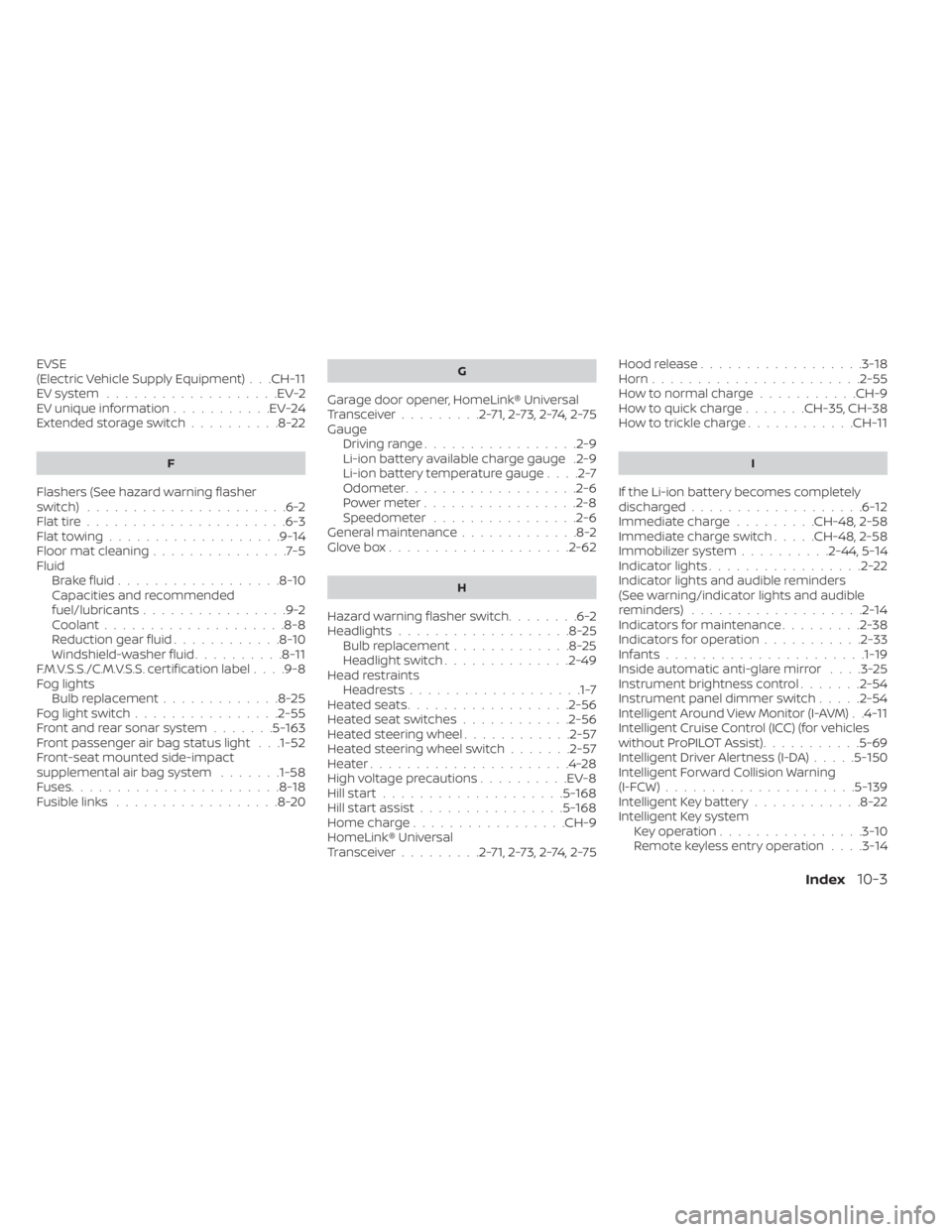
EVSE
(Electric Vehicle Supply Equipment). . .CH-11EV system...................EV-2EV unique information...........EV-24Extended storage switch..........8-22
F
Flashers (See hazard warning flasher
switch)......................6-2Flat tire..................... .6-3Flat towing...................9-14Floor mat cleaning...............7-5Fluid
Brake fluid..................8-10Capacities and recommended
fuel/lubricants................9-2Coolant................... .8-8Reduction gear fluid............8-10Windshield-washer fluid..........8-11F.M.V.S.S./C.M.V.S.S. certification label. . . .9-8Fog lights
Bulb replacement.............8-25Fog light switch................2-55Front and rear sonar system.......5-163Front passenger air bag status light. . .1-52Front-seat mounted side-impact
supplemental air bag system.......1-58Fuses.......................8-18Fusible links..................8-20
G
Garage door opener, HomeLink® Universal
Transceiver.........2-71,2-73,2-74,2-75GaugeDriving range................ .2-9Li-ion battery available charge gauge.2-9Li-ion battery temperature gauge. . . .2-7Odometer.................. .2-6Power meter.................2-8Speedometer................2-6General maintenance.............8-2Glove box................... .2-62
H
Hazard warning flasher switch........6-2Headlights...................8-25Bulb replacement.............8-25Headlight switch..............2-49Head restraints
Headrests...................1-7Heated seats................. .2-56Heated seat switches............2-56Heated steering wheel............2-57Heated steering wheel switch.......2-57Heater......................4-28High voltage precautions..........EV-8Hill start....................5-168Hill start assist................5-168Home charge.................CH-9HomeLink® Universal
Transceiver.........2-71,2-73,2-74,2-75
Hood release..................3-18Horn...................... .2-55How to normal charge...........CH-9How to quick charge.......CH-35, CH-38How to trickle charge............CH-11
I
If the Li-ion battery becomes completely
discharged...................6-12Immediate charge.........CH-48, 2-58Immediate charge switch.....CH-48, 2-58Immobilizer system..........2-44, 5-14Indicator lights.................2-22Indicator lights and audible reminders
(See warning/indicator lights and audible
reminders)
...................2-14Indicators for maintenance.........2-38Indicators for operation...........2-33Infants......................1-19Inside automatic anti-glare mirror. . . .3-25Instrument brightness control.......2-54Instrument panel dimmer switch.....2-54Intelligent Around View Monitor (I-AVM). .4-11Intelligent Cruise Control (ICC) (for vehicles
without ProPILOT Assist)...........5-69Intelligent Driver Alertness (I-DA).....5-150Intelligent Forward Collision Warning
(I-FCW).....................5-139Intelligent Key battery............8-22Intelligent Key system
Key operation................3-10Remote keyless entry operation. . . .3-14
Index10-3
Page 590 of 596
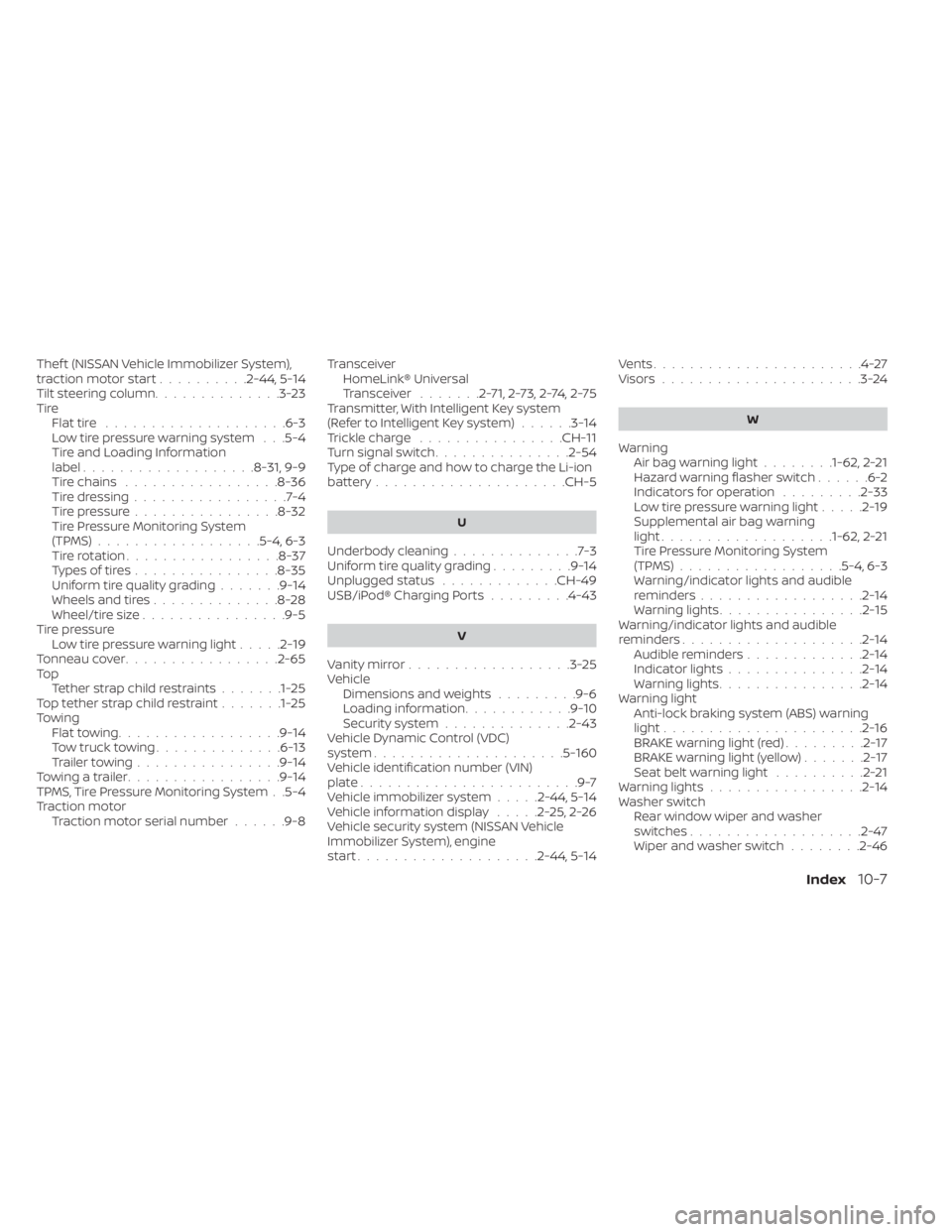
Thef t (NISSAN Vehicle Immobilizer System),
traction motor start..........2-44, 5-14Tilt steering column..............3-23TireFlat tire................... .6-3Low tire pressure warning system. . .5-4Tire and Loading Information
label...................8-31, 9-9Tire chains.................8-36Tire dressing.................7-4Tire pressure................8-32Tire Pressure Monitoring System
(TPMS)................. .5-4, 6-3Tire rotation.................8-37Types of tires................8-35Uniform tire quality grading.......9-14Wheels and tires..............8-28Wheel/tire size................9-5Tire pressure
Low tire pressure warning light.....2-19Tonneau cover................ .2-65To p
Tether strap child restraints.......1-25Top tether strap child restraint.......1-25TowingFlat towing..................9-14Tow truck towing..............6-13Trailer towing................9-14Towing a trailer.................9-14TPMS, Tire Pressure Monitoring System. .5-4Traction motorTraction motor serial number......9-8
TransceiverHomeLink® Universal
Transceiver
.......2-71,2-73,2-74,2-75Transmitter, With Intelligent Key system
(Refer to Intelligent Key system)......3-14Trickle charge................CH-11Turn signal switch...............2-54Type of charge and how to charge the Li-ion
battery.................... .CH-5
U
Underbody cleaning..............7-3Uniform tire quality grading.........9-14Unplugged status.............CH-49USB/iPod® Charging Ports.........4-43
V
Vanity mirror..................3-25Vehicle
Dimensions and weights.........9-6Loading information............9-10Security system..............2-43Vehicle Dynamic Control (VDC)
system.....................5-160Vehicle identification number (VIN)
plate........................9-7Vehicle immobilizer system.....2-44, 5-14Vehicle information display.....2-25,2-26Vehicle security system (NISSAN Vehicle
Immobilizer System), engine
start
................... .2-44, 5-14
Vents.......................4-27Visors......................3-24
W
Warning
Air bag warning light........1-62, 2-21Hazard warning flasher switch......6-2Indicators for operation.........2-33Low tire pressure warning light.....2-19Supplemental air bag warning
light.................. .1-62, 2-21Tire Pressure Monitoring System
(TPMS)..................5-4, 6-3Warning/indicator lights and audible
reminders..................2-14Warning lights................2-15Warning/indicator lights and audible
reminders....................2-14Audible reminders.............2-14Indicator lights...............2-14Warning lights................2-14Warning light
Anti-lock braking system (ABS) warning
light
......................2-16BRAKE warning light (red).........2-17BRAKE warning light (yellow).......2-17Seat belt warning light..........2-21Warning lights.................2-14Washer switchRear window wiper and washer
switches
.................. .2-47Wiper and washer switch........2-46
Index10-7